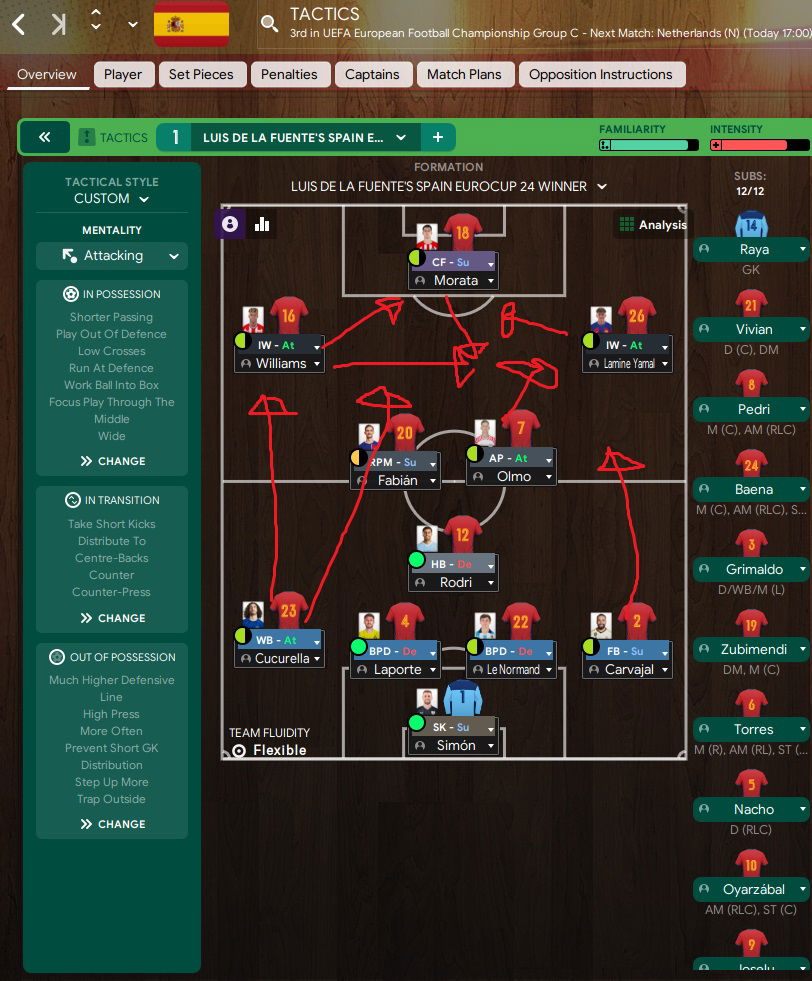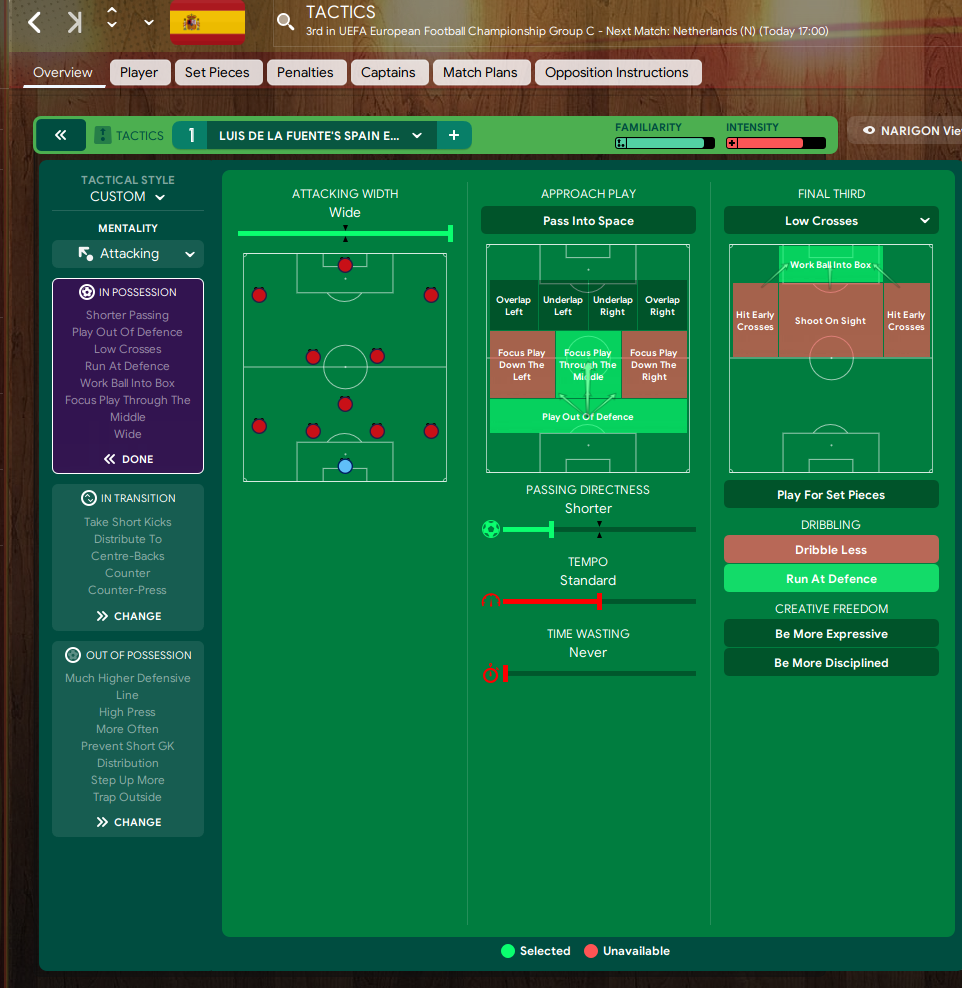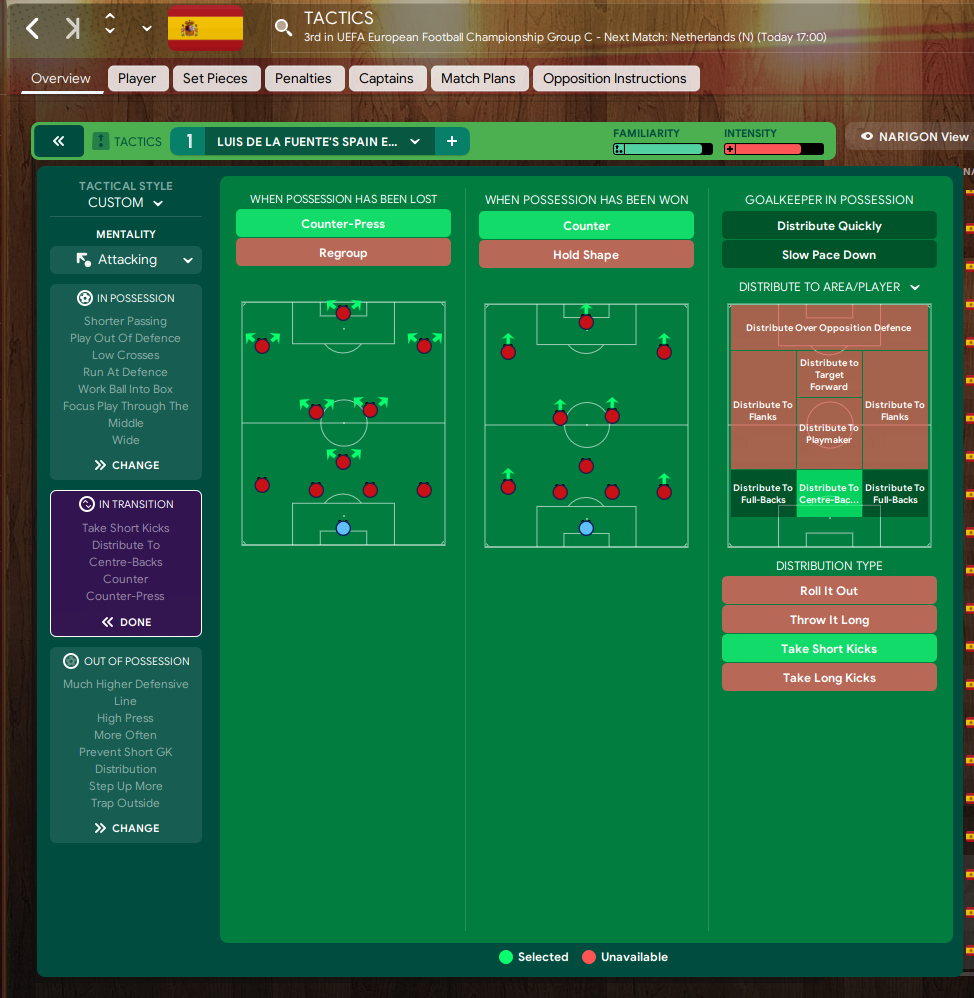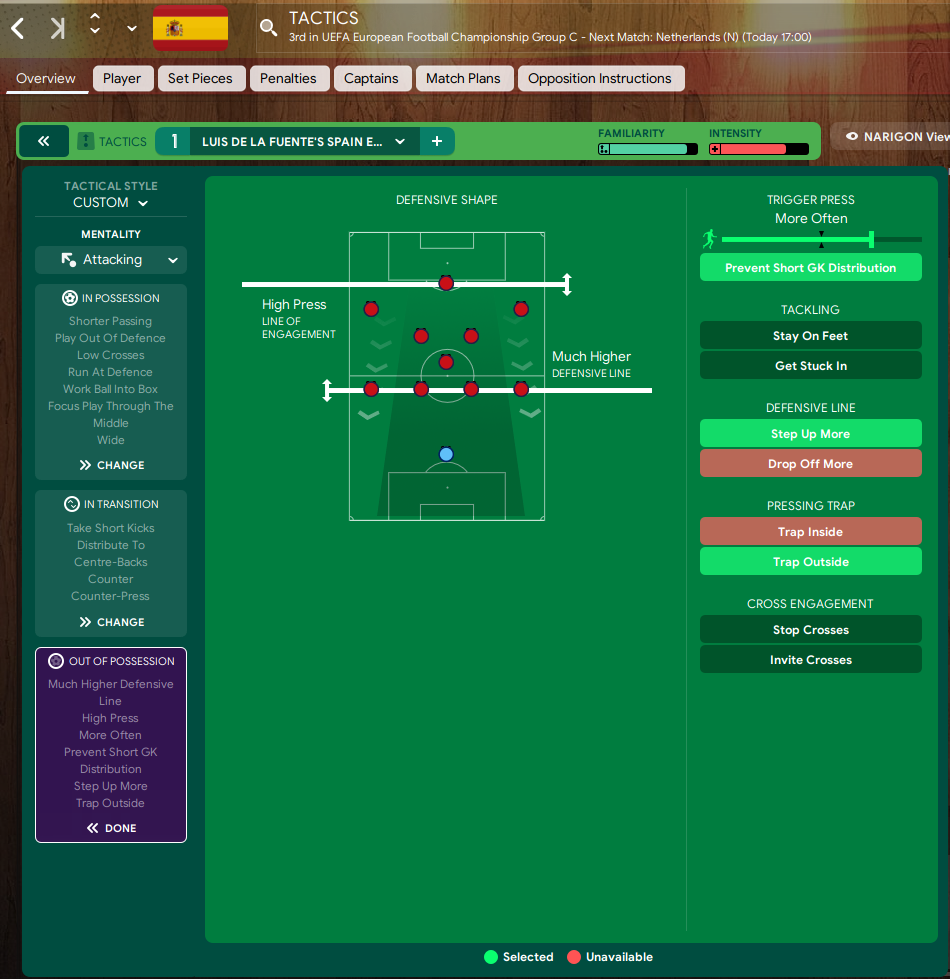| Tester | Team | ME | Win % | PPG | AGF | AGA | GD | PL | W | D | L | |
|---|---|---|---|---|---|---|---|---|---|---|---|---|
| Deleted User #1866315 |
 Spain
Spain
|
24.3 | 100% | 3 | 2.6 | 0.0 | 2.57 | 7 | 7 | 0 | 0 |
Hi guys, this time I emulated the tactic that allowed Spain to win the UEFA EURO CUP last month in Germany.
Spain – Luis de la Fuente – Tactical Analysis
Spain's national football team has long been celebrated for its tactical ingenuity and success on the international stage. Under the new leadership of Luis de la Fuente, La Roja continues this legacy with a fresh approach. In this analysis, we explore the tactical framework de la Fuente utilizes, highlighting how his methods build on Spain’s storied history while integrating new strategies to keep the team competitive globally. From formations and key player roles to in-game adjustments, we dissect the tactical nuances that characterize de la Fuente’s Spain, shedding light on their pursuit of possession dominance, scoring opportunities, and defensive solidity.
Build-up
De la Fuente organizes his team in a 1-4-3-3 formation during the build-up phase, featuring a back four, a lone number six, two number eights, and a front three.
The fullbacks position themselves wide, which forces the opposition’s wingers to spread out. This widens the opposition’s midfield, creating passing lanes from Spain’s center-backs to their midfielders.
During high build-up situations, the wingers tend to move inside, allowing the fullbacks to advance further up the pitch, resulting in a 1-2-3-5 formation.
This setup places eight players in central areas, with one on each wing, creating more options in the middle and reducing the space between players. De la Fuente favors this structure because he prioritizes playing through the center. He ensures one player stays high and wide to stretch the opposition’s backline while the rest generate numerical superiority in midfield. This approach also enhances Spain’s defensive transitions, enabling more players to press immediately after losing possession. Additionally, clustering players in the middle shortens the passing distances, which speeds up the play and gives the opposition less time to apply pressure, affording Spanish players more time and control.
Maintaining Possession
Luis de la Fuente’s Spain places a strong emphasis on retaining possession, a hallmark of Spanish football. The team meticulously builds from the back, using short, precise passes to progress up the field and maintain control. Midfielders play a crucial role, constantly moving to create passing lanes and support their teammates, ensuring that Spain dominates the ball. This possession-based strategy not only helps control the game’s tempo but also reduces the opposition’s chances by limiting their time with the ball. De la Fuente’s focus on technical skill and spatial awareness ensures that Spain can patiently dismantle defensive setups, waiting for the opportune moment to strike.
High Backline (Offense)
A key element of De la Fuente’s possession-oriented build-up is maintaining a high backline. This tactic aids in counter-pressing by keeping players closer to the center of the pitch. With more players near the center, Spain can quickly win back possession, making it difficult for the opposition to capitalize when they regain the ball. Additionally, the high backline reduces the distance between players, shortening the time and length of passes, and preventing the opposition from pushing their defense forward.
Linking with the Striker
De la Fuente’s approach often involves creating central overloads during attacks. As part of this strategy, Spain’s striker, Morata, frequently drops deeper during the build-up phase. When the striker drops, it opens up more opportunities to break down the opponent’s defense. The ball can be passed to the striker, who can either find a number eight in the pocket or make a one-touch pass to the winger.
If the opposing center-back follows the striker, it creates space behind them, which Spain can exploit with runs from the wingers or number eights.
Finding the Pockets
De la Fuente’s team consistently seeks to find the number eights in the pockets of space behind the opposition’s midfield. With the fullbacks wide, passing lanes from the center-backs to the number eights open up. Spain’s front three pin back the opposition’s defense, preventing them from advancing on the number eights. They look for passes from the backline that break the lines, finding a number eight who can then turn and drive toward the defense.
Runs in Behind
A new dimension that Luis de la Fuente has introduced to Spain’s build-up is a greater threat in behind the opposition’s defense. With rapid wingers like Lamine Yamal, Nico Williams, and Ferran Torres, Spain has become much more direct than in the past. These wingers constantly make runs in behind the defense when the ball is with the defenders or midfielders, creating numerous goalscoring opportunities from dangerous through-balls.
This persistent threat also forces the opposition to avoid playing a high backline, as they need to protect the space behind them. As a result, they drop deeper, which opens up space in front of their backline for Spain’s technically proficient midfielders to exploit.
Numerical Advantages
Another critical aspect of Spain’s high build-up is their ability to create numerical advantages against the opposition’s defensive line. When the fullbacks advance to form a 1-2-3-5 formation, Spain’s front five naturally outnumber the opposition’s backline, which they skillfully exploit.
For instance, when the defending team is concentrated on one side, the weak-side fullback becomes vulnerable to a long switch of play due to the 1v2 situation against Spain’s winger and fullback. The winger makes a run in behind, the opposition’s fullback follows, and the space out wide opens up for the Spanish fullback. De la Fuente’s team often capitalizes on this by getting the ball to the winger and creating numerous opportunities from 2v1 situations on the wing and in the half-spaces.
Final Third
Attacking the Half-Space
De la Fuente’s teams frequently aim to create chances by attacking the space between the opposition’s center-back and fullback, particularly from wide areas using underlapping runs from the number eights. When the winger receives the ball, they draw the opposition fullback, which opens up space between the fullback and center-back for the number eight to exploit with an underlapping run. The ball can then be played to the number eight, who can either cross into the box or take on the defender in a 1v1 situation.
The winger doesn’t always have to pass to the underlapping player. Often, the underlapping run will draw away a defensive midfielder, opening up space inside. The winger can then cut inside to shoot or find a pass to a free player in front of the backline.
De la Fuente’s team also exploits the space between the center-back and fullback by playing through-balls from midfield or the backline into a run from an attacker.
Overlaps
Spain also utilizes overlapping runs to create opportunities in the final third. When the winger receives the ball, the Spanish fullback will quickly overlap, creating a 2v1 situation on the wing. If the opposition fullback drops to cover the overlap, the winger can cut inside to shoot or combine with a midfielder. If the fullback covers the center, the ball can easily be played to the overlapping player, leading to a crossing opportunity.
Many Players in the Box
The number eights and wingers frequently make runs into the box when the ball is in the final third, often getting four or five players into these areas to create overloads. These numerical advantages in the box force the defending team to make quick decisions, often leaving some Spanish players unmarked.
De la Fuente also positions several players outside the box, ready for second balls and cut-backs. By consistently pushing the opposition’s defense deep, they open up space in front of the backline. Spain’s midfielders often find themselves in these spaces, where they can shoot or combine with an attacker to create goalscoring opportunities.
Defending
High Press
De la Fuente’s Spanish team applies a high press whenever possible, using a 1-4-1-3-2 formation.
Many teams adopt a 1-4-3-3 formation during the build-up, giving them a numerical advantage deep in their half against Spain’s six midfielders and forwards. De la Fuente counters this by leaving the opposition’s weak-side fullback unmarked and going man-to-man on the other players when the ball is played to one side. The wide midfielder on the ball side pressures the opposition’s fullback, the holding midfielder pushes up on the opposition’s number eight, and the wide midfielder on the weak side tucks in to control the opposition’s weak-side number eight.
This works because the pass from one side to the other is difficult for the ball-holder to make, and even if they do make it, the Spanish players have enough time to shift across and win the ball. This system also gives Spain a numerical advantage against the opposition’s striker, giving them more control when defending long balls.
Low Press
In a low press, De la Fuente’s Spain sets up in a 1-4-5-1 formation. They aim to establish a mid-block, consistently closing off the center and forcing the opposition wide. De la Fuente instructs his midfielders to man-mark the opposition’s midfielders, with the wingers tracking the opposition’s fullbacks. This approach results in a very dynamic defensive shape, with Spain’s midfield five often forming asymmetrical shapes and formations.
The man-to-man system complicates the opposition’s efforts to find free players, but it can also lead to confusion among the Spanish players when facing fluid teams that frequently change positions.
Striker Morata usually remains high up when defending, blocking one of the opposition’s center-backs and making it difficult for them to switch play. When a central midfielder steps out to press one of the center-backs, the other center-back becomes isolated. This forces the opposition to either pass back to the goalkeeper or play the ball forward, where Spain is ready to regain possession.
high Backline (Defense)
One tactic that helps Spain stay compact is their high backline, which significantly reduces the space between the midfield and defense.
Maintaining a high line allows Spain to remain compact while having more players available in the center of the pitch. This makes it difficult for the opposition to find space, and even when they do, they quickly encounter more defenders who close down any openings.
Spain’s high line also facilitates a high press, which proves very effective in regaining possession.
Conclusion
Luis de la Fuente’s tactical evolution has brought a new dimension to Spain’s football. His team is built on a foundation of possession, quick ball circulation, and smart positioning, all while maintaining the traditional Spanish emphasis on technical skill and spatial awareness. De la Fuente’s strategies have modernized Spain’s playstyle, making them more direct and unpredictable in attack, while still emphasizing defensive solidity. With his innovative approach, Spain is not only preserving its rich footballing heritage but also adapting to the demands of the modern game, positioning itself as a formidable force on the international stage.
HOW TO EMULATE THIS TACTIC IN FOOTBALL MANAGER 2024
In Football Manager 2024, to replicate this tactic I set up my formation as a 4-3-3 (but you can set up as a 4-2-3-1 with one of the two 8s, Dani Olmo, going forward and acting as a false 10 close to Morata). Our Gk, Unai Simon is a sweeper keeper in support, he will help to build from the back. Carvajal on the right is a full-back on support, he pushes less forward than Cucurella on the left, a wing-back on attack. Both stay wider and stretch the opposition's defense while Le Normand and Laporte are two Ball playing defenders in defend. Rodri is an half-back who drops deeps and helps the defense, while the other two midfielders are two number eight who will push forward and roam a lot, thus RPM and AP roles. Two inverted wingers who will cut inside and especially Nico, rotate position with the full-back. and a complete forward who drops deeper and links the play.
Team instructions; play wide, play from defense, focus play in the middle,shorter passes and standard tempo, work the ball to the box and run to defense, counterpress and counter, much higher defense and pressing line.
Test Results
 Spain
Spain
You'll need to Login to comment




